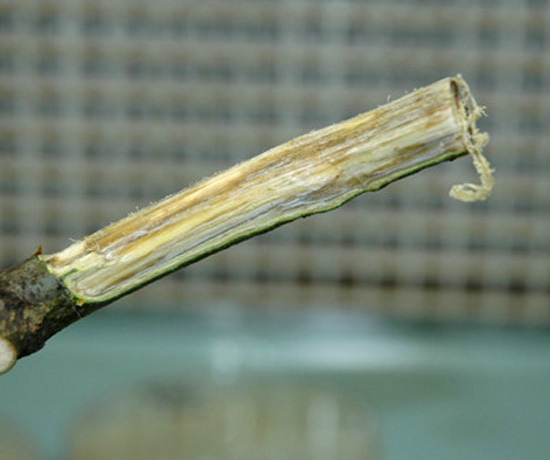Issue 9, June 19, 2009
Oak Wilt or Look Alike?
Oak wilt is a lethal disease to infected oaks. Additionally, it may spread by root grafts (root connections) between oaks or it may spread overland by beetles carrying the causal fungus. If you have established oaks, this can be frightening. It may also cause some confusion as to symptoms in your trees. The first place to check for more information is the University of Illinois web site housing the oak wilt report on plant diseases. There you can read about symptoms and look at some pictures that will help. Another site I would recommend is http://www.na.fs.fed.us/spfo/pubs/howtos/ht_oakwilt/toc.htm. This site is developed by the national forest service. It provides some practical information and look alike diseases to consider.
Oak wilt is a vascular disease caused by a fungus that plugs up the vascular system of the tree. The foliage of the infected tree may become scorched or it may turn gray-green or tan. The effect will not go unnoticed, especially if the tree is a landscape tree, but it is important to notice symptoms as soon as possible to help surrounding oaks. The disease progresses quickly, killing mature trees in the red oak group in one season. The symptoms often start in the top of the tree, so don’t neglect looking there for problems. Binoculars work well for large trees. Vascular diseases such as oak wilt are more apparent now that other foliage is deep green. If you see a problem on your oak, look at other tree species in the area. Oak wilt infects only oaks. If other trees are showing similar symptoms, then consider site or environmental stress factors.
Leaf symptoms vary depending on the oak species involved. Generally oaks in the red or black oak group (pointed leaf lobes) develop discolored and wilted leaves at the top of the tree or at the tips of the lateral branches in late spring and early summer. The leaves curl slightly and turn a dull pale green, bronze, or tan, starting at the margins. Usually by late summer, an infected tree has dropped all its leaves. In some years we have seen red oaks progress from scorched foliage to total defoliation in as little as three weeks.
The white and bur oak group (rounded leaf lobes) generally shows symptoms on scattered branches of the crown. The disease is often confused with general dieback and decline. Leaves on infected white oaks become light brown or straw-colored from the leaf tip toward the base. The leaves curl and remain attached to the branches. This tree group may die in one season but is much more likely to survive for many years with dieback and stressed appearance.
Vascular discoloration is probably the most important clue that oak wilt is a strong possibility. The images show vascular discoloration on a branch section with bark peeled away and the ring of discoloration visible in a stem cross section. Sometimes an entire ring may not be visible, but you will see sections of a ring, maybe even brown blotches in a ring pattern. Discoloration in the center of the stem is not associated with oak wilt.


If you are going to sample a tree for oak wilt testing, do so before any chemicals are applied. Find live, symptomatic branches with vascular discoloration. Samples should be 8 to 10 inches long and about thumb thickness. It takes 7-10 days for the fungus to develop in the lab to the point where a positive confirmation can be made from cultures. The processing time cannot be shortened. Oak samples submitted for oak wilt testing should be sent on disposable ice packs (the blue packs, not bags of ice) to prevent killing the fungus (in mail trucks) with high temperatures before it can be isolated in the lab.
If you have oak wilt in your area, do not prune oaks now. Pruning when trees are actively growing results in sap flow, attracting the beetles that may carry the fungal pathogen to your tree. Both the beetles and the fungus are now active. If oak wilt is present in your area, try to leave pruning of oaks until at least after mid-summer. The dormant season would be an even better time for this task.--Nancy Pataky
Author:
Nancy Pataky